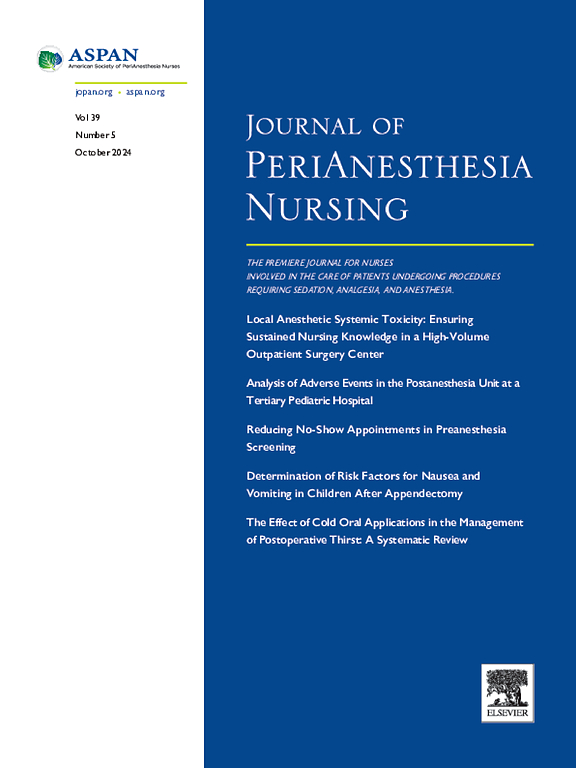择期剖宫产术前口服含碳水化合物液体与白开水的对比:随机临床试验。
IF 1.6
4区 医学
Q2 NURSING
引用次数: 0
摘要
目的:最近,传统的长时间禁食方案已被在手术前 2 小时之前服用富含碳水化合物的清流液的指导原则所取代。通过这项研究,我们想了解在术前口服液中添加碳水化合物是否有任何好处:随机临床试验:研究在北印度的一个中心进行,对象是足月的单胎妊娠,计划在蛛网膜下腔阻滞下进行择期剖宫产。参与者被随机分为两组,每组 50 人。碳水化合物组 "在手术前 2 至 4 小时接受 400 毫升含 50 克葡萄糖的液体,而 "白开水组 "在手术前 2 至 4 小时接受 400 毫升白开水。手术前使用视觉模拟量表评估饥饿、口渴、焦虑、疲劳和恶心程度。术中注意平均动脉压、低血压、恶心和呕吐。术后第一天,使用麻醉恢复质量-40(QoR-40)问卷评估麻醉恢复情况。比较了术后第一天的血糖水平和脐带血中的血糖水平:两组患者术前在饥饿、口渴、焦虑、恶心和疲劳方面的视觉模拟量表评分相似。两组的低血压发生率(P = .688)和苯肾上腺素使用率(P = .39)、麻醉后恢复情况(P = .92)、脐带血糖水平(P = .24)和术后血糖水平也无显著差异(P = .81):本研究未发现在蛛网膜下腔阻滞下进行择期剖宫产的产妇术前饮用含碳水化合物的液体比术前饮用白开水有任何明显优势。本文章由计算机程序翻译,如有差异,请以英文原文为准。
Preoperative Oral Carbohydrate-Containing Fluid Versus Plain Water in Elective Cesarean Deliveries: A Randomized Clinical Trial
Purpose
Traditional prolonged fasting regimens have recently been replaced with guidelines to take carbohydrate-rich clear fluids until 2 hours before surgery. With this study, we wanted to study if the addition of carbohydrates to preoperative oral fluids confers any advantage.
Design
Randomized clinical trial.
Methods
The study was conducted at a single center in North India among singleton pregnancies at term, scheduled for elective cesarean section under subarachnoid block. Participants were randomized into 2 groups of 50 participants each. The “Carbohydrate group” received 400 mL of fluid containing 50 g of glucose, while the “plain water” group received 400 mL of water 2 to 4 hours before surgery. A visual analog scale was used to assess hunger, thirst, anxiety, fatigue, and nausea before surgery. Intraoperative mean arterial pressure, hypotension, nausea, and vomiting were noted. On the first postoperative day, recovery from anesthesia was assessed using the Quality of recovery from anesthesia- 40 (QoR-40) questionnaire. Blood sugar levels were compared on the first postoperative day and in cord blood.
Findings
Preoperative visual analog scale scores for hunger, thirst, anxiety, nausea, and fatigue were similar in both groups. The occurrence of hypotension (P = .688) and phenylephrine use (P = .39), recovery from anesthesia (P = .92), cord blood sugar levels (P = .24), and postoperative blood sugar levels were also not significantly different in both groups (P = .81).
Conclusion
This study did not find any significant advantage of preoperative carbohydrate-containing fluid over preoperative plain water in women undergoing elective cesarean delivery under Subarachnoid block.
求助全文
通过发布文献求助,成功后即可免费获取论文全文。
去求助
来源期刊

Journal of Perianesthesia Nursing
NURSING-
CiteScore
2.20
自引率
17.60%
发文量
279
审稿时长
90 days
期刊介绍:
The Journal of PeriAnesthesia Nursing provides original, peer-reviewed research for a primary audience that includes nurses in perianesthesia settings, including ambulatory surgery, preadmission testing, postanesthesia care (Phases I and II), extended observation, and pain management. The Journal provides a forum for sharing professional knowledge and experience relating to management, ethics, legislation, research, and other aspects of perianesthesia nursing.
 求助内容:
求助内容: 应助结果提醒方式:
应助结果提醒方式:


